Initiating on an adventure that seamlessly blends the calmness of camping with the exhilaration of paddling, canoe camping offers adventurers a unique opportunity to connect with nature on a profound level.
We have divided this blog into multiple sections like essential preparation, preparing for canoeing trips and camping. We have answered questions like when, how, what and why to make things simpler for you.
And to top it all off, we have mentioned some of the most popular places in US and Canada where you would enjoy your canoeing trip in the best why possible.
Key Takeaways on Canoe Camping
Do I need previous canoeing experience to go canoe camping – Canoe camping in wilderness areas can be safely undertaken by beginners with the proper preparation. Practice paddling skills and learn basic safety techniques before your trip.
How do I stay safe while canoe trip – Ensure good canoe paddling technique, practice canoe/kayak safety techniques, and have the necessary equipment such as Canoeing Accessories including canoe life jacket. Check the weather in advance and pack essential items for survival.
What not to do While Canoe Camping – Avoid overpacking unnecessary items, neglecting to check weather and water conditions, and disregarding safety precautions. Respect the environment and follow Leave No Trace principles.
Who shouldn’t go for a canoeing trip – Individuals who are uncomfortable around water, have medical conditions that may be aggravated by physical activity or cannot swim should reconsider canoeing trips for their safety.
Canoe Camping Guide Explained in Steps
Here is a detailed guide with all the steps explained for you to have the best canoe trip experience:
Essential Preparations
Selecting the Right Canoe
Selecting the right canoe is essential for a successful canoe camping trip. Here are some factors to consider when choosing a canoe:
Single or Double?
Canoes usually have seats for two rowers, but some can accommodate a single paddler. Consider the number of people in your group and the weight of your gear when choosing a canoe.
Our Recommendation: Sea Eagle TC16 Inflatable 16′ High-Pressure Drop Stitch Travel Canoe

The Sea Eagle TC16 Inflatable 16′ High-Pressure Drop Stitch Travel Canoe is a portable and versatile canoe that offers exceptional stability and buoyancy. It features a breakthrough design with patented high-pressure drop stitch construction, making it durable and rigid.
The canoe has flat three-inch high-pressure side and floor chambers, creating a narrow and spacious interior. Canoe is easy to transport, set up, and stow, fitting in a small car trunk or closet. The TC16 is suitable for use on lakes, rivers, and bays.
Open-Deck or Closed-Deck Canoes or Inflatable
Canoes with an open deck allow for easier getting into a canoe and exit, while closed-deck canoes provide more protection from the elements. Consider the weather and water conditions you’ll be paddling in when choosing a canoe.
Our Recommendation: Aqua Marina Ripple-370 Canoe for 3 Person 2022
The Aqua Marina Ripple-370 Canoe is a versatile and durable inflatable canoe designed for recreational activities. It can comfortably accommodate up to three people and is suitable for fishing, camping, and island hopping.
The canoe features a rugged drop-stitch hull for stability and durability. It has an ultra-comfortable deck floor and a generous warming-up area, providing a safe and enjoyable experience on the water.
The canoe is constructed with CO-FABRIC™ material, ensuring durability and reliability. It is easy to transport and inflate, making it convenient for outdoor adventures.
Material
Canoes can be made of various materials, including aluminium, fibreglass, and wood. Each canoe material has its pros and cons regarding weight, durability, and cost.
Each material has advantages and considerations, such as weight, durability, maintenance, and cost.
But according to our experience, wood is used for its durability and aesthetic appeal, Royalex or TuffStuff for whitewater canoe paddling, carbon fibre or kevlar for wilderness trips, and PVC, polyester, or nylon for travel canoes
Waterways
Consider the type of waterways you’ll paddle on, such as calm lakes or fast-moving rivers. Some canoes are better suited for specific water conditions.
Old Town Sportsman Discovery Solo 119 Fishing Canoe
The Old Town Sportsman Discovery Solo 119 Fishing Canoe is a versatile and stable watercraft suitable for anglers and hunters. It has an open, spacious hull that can accommodate fishing crates, camping gear, and other equipment.
The canoe is lightweight at 56 lbs, making it easy to transport. The seat position allows for paddling with a single or double-blade paddle like kayak paddle, and the Comfort Flex kayak-style seat is adjustable and padded for comfort.
The canoe also has built-in cup holders, padded armrests with trays for tackle, and kayak-like agility.
Overall Weight (Paddlers & All Equipment)
The canoe’s weight, paddlers, and gear is an important consideration, as you may sometimes need to carry the canoe. Choose a canoe that can comfortably accommodate your group and gear without being too heavy.
Choosing the Proper Camping Gear
1. Where You Will Put Everything (Paddling Equipment)
Essentials for manoeuvring include canoe/kayak, paddles, and life jackets. Pack gear in waterproof bags, securing them in the boat to prevent water damage and ensure balanced weight distribution.
Our Recommendation: Earth Pak -Waterproof Dry Bag – Roll Top, Dry Compression Sack, Keeps Gear Dry for Kayaking
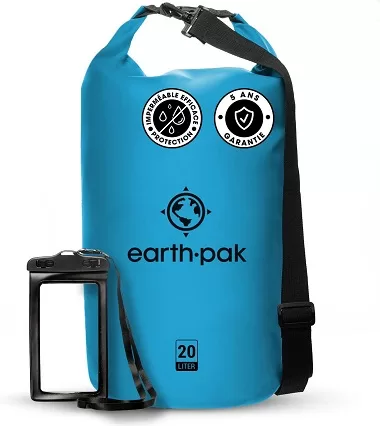
The Earth Pak Waterproof Dry Bag is a reliable and durable solution for keeping your gear dry during kayaking, beach trips, rafting, boating, hiking, camping, and fishing. It is made with thick and waterproof 500D PVC fabric, providing protection from abrasion and ensuring the safety of your valuable items.
The bag features a roll-top closure, which creates a watertight seal to keep water out. It also comes with a waterproof phone case for added convenience.
Our Recommendation for where to put everything: 20 Litre Recreational Barrel Works Canoe Barrel
2. Shelter and Sleeping Equipment
Choose a lightweight tent or hammock with a rainfly for camp. Bring a sleeping bag and pad for insulation and comfort, tailored to weather conditions and personal preferences.
Our Recommendation: Eureka! Suma Backpacking Tent
The Eureka! Suma Backpacking Tent is a lightweight, budget-friendly tent for long backpacking trips. It is Eureka’s lightest backcountry tent, making it easy to carry and transport.
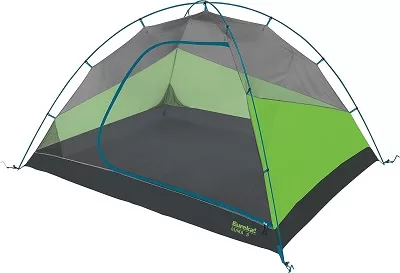
The tent features a dual-pole system, breathable mesh walls for ventilation, and a fly and floor treatment to resist abrasion and weather.
3. Cooking and Food Supplies
You can travel with a portable stove, cookware, utensils, and biodegradable soap for cooking. Plan meals, bring non-perishable foods, and pack them in waterproof containers. Use bear-resistant food storage in areas with wildlife.
Our Recommendation: Chef-Master 90235 Butane Countertop Range/Stove – 12,000 BTU
The Chef-Master 90235 Butane Countertop Range/Stove is a portable and powerful stove that can be used indoors and outdoors. It has a high heat output of 12,000 BTUs and an adjustable heat range from simmer to boil.
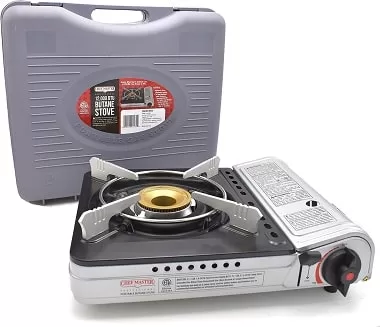
The stove features a brass burner, double wind guard, and electronic ignition for easy and safe use. It comes with a high-impact carrying case for easy transport and storage.
4. Clothing and Personal Items
Wear moisture-wicking, quick-dry clothing while paddling. Pack extra clothing, rain gear, and warm layers.
For Campsite you can wear comfortable, warm clothing and canoeing shoes. Remember personal medications and hygiene items.
5. Safety and Navigation Gear
There are some essentials you need to carry for emergencies. These include a first aid kit, emergency communication devices (whistle, flare, or satellite messenger), a map, a compass, and GPS if needed. Personal flotation devices (PFDs) are vital for everyone onboard.
Our Recommendation: Ocean Signal RESCUEME PLB1 Personal Locator Beacon
The Ocean Signal RESCUEME PLB1 Personal Locator Beacon is a compact and lightweight device designed to provide reassurance and alert emergency services with a button. It is the smallest PLB available and offers a 7-year battery life.
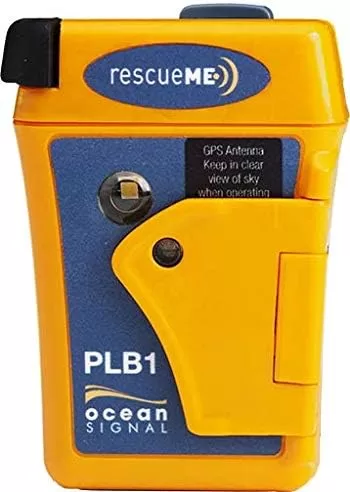
The PLB1 features a GPS receiver, high-intensity strobe light, and a retractable antenna. It is waterproof up to 15 meters and has a homing beacon to assist search and rescue teams in locating your position.
6. Some Other Stuff To Bring
- Sweater or fleece
- Water purification system
- Fire starting equipment
- Tarp
- Groundsheet
- Rope or cord
- Multi-purpose tool or knife
- Headlamp or flashlight
- Insect repellent
- Fishing gear (if desired)
- Binoculars
- Camera
- Selecting the right tent/hammock and other important stuff
- Tent: Choose a tent appropriate for the number of people and weather conditions you’ll be camping in. Look for features like waterproof material, sturdy construction, and easy setup.
- Hammock: Invest in a hammock explicitly designed for camping. These are more durable and can withstand the elements and tree suspensions. The right camping hammock will also meet your length and weight needs.
Our Recommendation: Wise Owl Outfitters Camping Hammock – Portable Hammock Single or Double Hammock
The Wise Owl Outfitters Camping Hammock is popular for outdoor enthusiasts seeking comfort and portability. It comes in single and double sizes, with the single hammock measuring 9 feet long by 4.5 feet wide and the double hammock measuring 10 feet long by 6.5 feet wide. The hammock is durable nylon with tree straps and carabiners for easy setup.
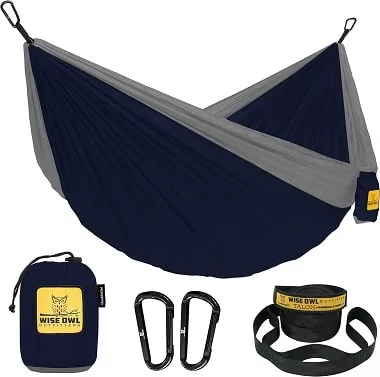
- Understanding Leave No Trace Principles
Leave No Trace is a set of outdoor ethics that promote responsible outdoor recreation.
Plan and prepare: This includes researching the area you’ll be camping in, bringing the right gear and equipment, and knowing the rules and regulations.
Dispose of waste properly: Pack out all trash and dispose of human waste properly. This includes burying at least 200 feet of waste from water sources and campsites in a cathole.
Leave what you find: Don’t disturb plants, animals, or cultural artifacts. Leave natural and cultural features as you find them.
Respect wildlife: Observe wildlife from a distance and don’t feed them. Store food and trash securely to avoid attracting animals.
Be considerate of other visitors: Keep noise levels down and respect the privacy of other campers. Follow established campsite rules and regulations.
Trip Planning
When planning a camping trip, selecting the right destination is crucial for a safe and enjoyable experience.
Destination Selection
1. Researching Waterways and Campsites
Before selecting a destination, research the waterways and campsites in the area. Look for information on water conditions, camping regulations, and available amenities.
A useful tip for researching waterways and campsites is joining online groups and surfing the internet.
2. Considering Skill Level and Experience
Choose a destination that matches your skill level and experience. If you’re a beginner, consider a location with easy terrain and accessible campsites. If you’re experienced, you should challenge yourself with more difficult terrain and remote campsites.
Mountainous terrains are not recommended for beginners due to their challenging nature and potential hazards. These terrains have highly variable terrain, steep slopes, limited accessibility, unpredictable weather conditions, and physical demands.
Before venturing into mountainous terrains, beginners should gain experience and develop the necessary skills.
Planning your Route
Research the waterways and campsites in the area you plan to visit. Consider the difficulty level of the waterways, the availability of campsites, and the distance you plan to travel each day.
Use online resources and maps to plan your route and determine how long it will take to complete your trip.
Obtaining Permits and Permissions
Some wilderness areas require command/paddling permits. Research the requirements for the area you plan to visit and obtain any necessary permits or permissions.
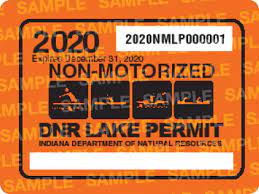
This may include reserving campsites in advance, paying fees, and following specific regulations for the area.
Remember the Elements
Consider the weather and other environmental factors when planning your trip. Pack appropriate clothing and gear for your conditions, and be prepared for weather changes.
Additionally, practice Leave No Trace principles to minimise your environmental impact. This includes packing trash and waste, avoiding damaging vegetation, and respecting wildlife.
Creating an Itinerary
1. Daily Paddling Distances and Time Estimates
Determine the distance you plan to paddle each day based on your skill level, experience, and the difficulty of the waterways. Consider factors such as wind, currents, and portages that may affect your speed and progress.
Estimate the time it will take to paddle each distance, considering breaks, meals, and rest stops. Keep in mind that paddling speeds can vary depending on the conditions.
2. Potential Campsites and Points of Interest
Research and identify potential campsites along your route. Consider availability, amenities (such as fire pits and picnic tables), and proximity to water sources.
Look for points of interest, such as scenic spots, hiking trails, fishing areas, or historical sites, that you may want to visit during your trip. Plan your itinerary to include stops at these points of interest.
Checking Weather and Water Conditions
When planning a canoe trip, you must check the weather and water conditions for the area you’ll be visiting. You can ensure a safe and enjoyable trip by checking the weather forecast, being aware of weather hazards, understanding waterway variables, and packing for changing conditions.
Take the time to research and plan accordingly, using resources like the Boundary Waters Canoe Area Wilderness Trip Planning Guide provided by the USDA Forest Service.
Going to Your Canoe Camping Destination and Paddling Technique
Going to your canoe camping destination
When going to your canoe trip destination, it’s important to pack appropriately, choose the right canoe, practice paddle technique, know the river, and secure your gear.
Pack only what you need in waterproof bags, have one canoe per two people, practice paddling on flatwater, familiarise yourself with the river, and tie down your gear. These tips will help ensure a safe and enjoyable trip.
Canoe Transportation, Rentals and Portaging
If you don’t own a canoe, you can rent one from a local outfitter. When transporting your canoe, ensure it is properly secured to your vehicle. If you need to portage (carry your canoe over land), make sure you have the necessary equipment, such as a yoke or portage wheels.
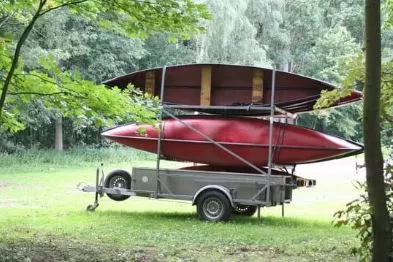
Canoe Handling Basics
Before hitting the water, ensure you know how to handle your canoe properly. This includes getting in and out of the canoe and how to distribute weight1 properly.
Paddling Strokes (Forward, Backward, Turning)
There are several paddling strokes you should know, including forward, backwards, and turning strokes. These will help you navigate your canoe more effectively.
Steering and Maneuvering
Besides paddling strokes, you should also know how to manoeuvre your canoe. This includes using your paddle as a rudder and leaning your body to turn the canoe.
Keep your boat light.
Pack only what you need when packing for your canoe and camp trip. A lighter boat will be easier to paddle and manoeuvre.
Safety Measures
PFDs and Proper Attire
Always wear a properly fitting personal flotation device (PFD) while on the water. PFDs provide buoyancy and can keep your head above water if you capsize. Ensure your PFD is Coast Guard-approved and the appropriate size for each person on board.
Communication Devices
Bring communication devices such as a whistle or a waterproof phone case to call for help in an emergency. It is important to have a way to contact help if needed.
Dealing with Emergencies
Be prepared to handle emergencies by carrying essential safety and first aid equipment. This may include items such as a first aid kit, a rescue throw bag, a signalling mirror, and a knife. Familiarise yourself with basic rescue techniques and self-rescue methods.
Setting Up Camp
Setting up camp is an important part of a canoe camping trip. Here are some tips to help you get started:
Finding Suitable Campsites
Research and plan to find suitable campsites. Look for established campsites away from the water’s edge and have a fire pit.
Tent Setup and Camp Layout
Choose a level and dry spot when setting up your tent. Consider the wind’s direction and the sun’s location when choosing your campsite. We suggest you set up your tent first, then organise your campsite layout around it.
Campfire Safety and Regulations
Check local regulations and fire restrictions before starting a campfire. Use an established fire pit and keep a bucket of water nearby. Never leave a fire unattended, and make sure it is completely extinguished before leaving.
Food Storage to Prevent Wildlife Encounters
Store your food and trash in a bear-resistant container or hang it from a tree at least 10 feet off the ground and 4 feet away from the trunk. This will help prevent wildlife encounters.
Cooking and Nutrition
There are several factors to consider regarding cooking and nutrition during a canoe camping trip.
Camp Cooking Equipment
Make sure you have the necessary cooking equipment for your trip. This may include a portable stove, fuel, pots, pans, utensils, and a cooler storing perishable food.
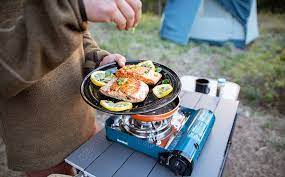
Meal Planning and Food Preparation
Plan your meals to ensure you have enough food for the entire vacation. To reduce the amount of equipment you need to carry and clean, combine meals that can be prepared in one pot.
Storing and Packing Food
Store and pack your food to keep it fresh and prevent wildlife encounters. Use airtight containers or resealable bags to keep food secure and organised. Consider using a bear-resistant container or hanging food from a tree to keep it out of reach of animals.
Managing Waste and Trash
Practice Leave No Trace principles by properly managing waste and trash. Pack out all trash and dispose of it properly when you return from your trip. Avoid leaving any food scraps or packaging behind that could attract animals.
Enjoying Nature Responsibly
Enjoying nature responsibly during a canoe camping trip is important to minimise the environmental impact and preserve the area’s natural beauty.
Leave No Trace Principles
Follow the seven Leave No Trace principles, which include planning and preparing, travelling and camping on durable surfaces, disposing of waste properly, leaving what you find, minimising campfire impact, respecting wildlife, and being considerate of other visitors.
Proper Waste Disposal
Pack all trash and leftover food, and dispose of human waste properly. Use established restroom facilities when available, or dig a small hole at least 200 feet away from water sources and bury human waste.
Minimising Campsite Impact
Choose established campsites when possible, and avoid creating new campsites or trails. Keep campsites small and focus activity in areas where vegetation is absent. Avoid altering the site or moving natural objects.
Wildlife Observation and Respect
Observe wildlife from a distance and do not approach or follow them. Never feed animals; it can damage their health and alter their natural behaviour.
Practising Sustainable Outdoor Behavior
Practice sustainable outdoor behaviour by minimising your impact on the environment. This includes using reusable containers and utensils, conserving water, and using biodegradable soap.
Navigating and Exploring
Navigating and exploring during a canoe camping trip can be an exciting part of the adventure.
Reading Water and Navigational Aids
Learn how to read the water to navigate safely. Look for patterns, eddies, and obstacles that may affect your paddling. Familiarise yourself with navigational aids such as maps, compasses, and GPS devices to help you navigate your route.
Exploring Surrounding Terrain
Take the time to explore the surrounding terrain and appreciate the area’s natural beauty. Hike along trails, climb hills for panoramic views, or take a leisurely walk to discover hidden gems.
Visiting Points of Interest
Research and plan to visit points of interest along your route. This could include waterfalls, historical sites, or unique natural features. Take the opportunity to learn about the area’s history and culture.
Evening Activities and Relaxation
When it comes to evening activities and relaxation during a canoe and camp trip, there are plenty of options to unwind and enjoy the outdoors.
Campfire Stories and Entertainment
Gather around the campfire, share stories, sing songs, or play musical instruments. This classic camping activity can create a cosy and memorable atmosphere.
Stargazing and Night-time Photography
Take advantage of the clear night skies away from city lights and spend time stargazing. Learn about constellations, identify planets, and appreciate the beauty of the night sky. If you’re into photography, try capturing stunning nighttime shots of the stars and landscapes.
Breaking Camp and Departure
When breaking camp and preparing to depart from your canoe camping trip, there are a few important considerations to ensure you leave the area in good condition.
Packing Gear Efficiently
Pack your gear in a way that maximises space and weight distribution. Use dry bags or waterproof containers to protect your belongings from water damage.
Make sure to secure everything properly to prevent items from shifting during transportation.
Double-Checking Campsite for Litter
Before leaving your campsite, thoroughly inspect the area for litter or trash. Pick up any garbage or food scraps and pack them out with you. Leave the campsite as clean as or cleaner than you found it.
Properly Disposing of Waste
Dispose of waste properly by following the principles of Leave No Trace. Pack out all trash, leftover food, and litter. Avoid leaving any waste behind, including biodegradable items like food scraps, as they can still negatively impact the environment.
Best Canoe Camping Spots in the US
Here are some of the best sports you can visit if you plan to go canoeing in the US:
The Boundary Waters Canoe Area Wilderness—Minnesota
Situated in northeastern Minnesota, the Boundary Waters Canoe Area Wilderness encompasses 1.1 million acres of untamed wilderness. This area is renowned for its unspoiled lakes, rugged landscapes, and abundant wildlife, including majestic moose and soaring bald eagles.
The Boundary Waters beckon canoe enthusiasts with the chance to engage in fishing, camping, and exploring secluded wild areas.
For the most enjoyable experience, the optimal time for canoeing within the Boundary Waters falls between June and September, when the weather tends to be warm and the water conditions are favourable.
Everglades National Park—Florida
Nestled in the southern reaches of Florida, Everglades National Park encompasses a sprawling 1.5 million acres of wilderness. This park is celebrated for its unique ecosystem, featuring expanses of sawgrass prairies, intricate mangrove forests, and serene freshwater sloughs.
Canoeing in the Everglades offers the thrill of encountering diverse wildlife, engaging in fishing pursuits, and embarking on journeys through remote corners of the park. The prime window for canoeing in the Everglades spans the dry season from December to April.
During this period, the weather is gentler, and the water levels are lower, allowing for an enhanced experience.
Green River—Utah
Carving its path through Utah, Wyoming, and Colorado, the Green River extends for 730 miles. Exploring the Green River by canoe unveils the awe-inspiring beauty of its canyons, the allure of embarking on hikes to remote locales, and the tranquillity of camping on secluded beaches.
Optimal for voyages between June and September, this timeframe aligns with warm weather and ideal water conditions, heightening the enjoyment of canoeing along the Green River’s course.
The Ozarks—Missouri, Arkansas, Oklahoma, and Kansas
Dominated by rolling mountains, the Ozarks form a picturesque region in the heart of the United States. This area is celebrated for its picturesque rivers, none more so than the Buffalo National River, which opens doors to canoeing, angling escapades, and immersive camping experiences.
The sweet spot for canoeing in the Ozarks coincides with the spring and fall seasons. These times offer milder weather and elevated water levels, creating an environment conducive to remarkable adventures.
Buffalo National River – Arkansas, USA
The Buffalo National River, meandering 153 miles through northern Arkansas, is a testament to natural wonder. Embarking on a canoe journey along the Buffalo River reveals the splendour of towering bluffs, the thrill of hiking to hidden treasures, and the serenity of camping on secluded beaches.
Spring and fall are optimal seasons for navigating the Buffalo River by canoe. These periods boast more temperate weather and higher water levels, enriching the experience.
Adirondack Canoe Route – New York, USA
Traversing upstate New York, the Adirondack Canoe Route extends across 740 miles, encompassing a network of 90 lakes and rivers. This expanse offers boundless prospects for exploration and the delight of camping amid stunning surroundings.
The prime time for embarking on a canoe adventure along the Adirondack Canoe Route falls in summer, spanning June to September. The weather tends to be warm during this span, and water conditions are favourable, providing an excellent backdrop for memorable journeys.
Best Canoe Camping Spots in Canada
Here are some of the best sports you can visit if you plan to go canoeing in Canada:
Algonquin Provincial Park
Algonquin Provincial Park is one of Canada’s most popular canoe camping destinations. It offers over 2,000 kilometres of canoe routes, making it a haven for paddlers of all skill levels.
The park is known for its small and calm lakes, well-maintained campsites, and the opportunity to spot wildlife like moose.
Over 1,200 backcountry campsites are spread throughout the park, providing flexibility for trip planning.
The best time to canoe in Algonquin Provincial Park is during the summer months from June to September when the weather is generally warm and the water conditions are favourable.
Woodland Caribou Provincial Park – Ontario, Canada
Woodland Caribou Provincial Park is in Northwestern Ontario and offers a remote and pristine canoe and camping experience.
The park features a network of interconnected lakes and rivers, providing a variety of routes for canoeists to explore.
The park is known for its rugged wilderness, stunning landscapes, and opportunities for wildlife sightings, including woodland caribou.
The best time to canoe in Woodland Caribou Provincial Park is during the summer months from June to September, when the weather is milder, and the water levels are higher.
Quetico Provincial Park – Ontario
Quetico Provincial Park is adjacent to Minnesota, USA’s Boundary Waters Canoe Area Wilderness. It offers a remote and wilderness canoe camping experience.
The park’s more than 2,000 lakes and rivers provide countless possibilities for solitude and exploration.
Moose, wolves, and bald eagles are just a few of the plentiful animals that may be found in Quetico’s natural environment, rocky terrain, and wildlife.
The summer months of June to September are great for canoeing at Quetico Provincial Park since the weather is often pleasant and the water is in good condition.
Nahanni National Park Reserve – Northwest Territories
Nahanni National Park Reserve is located in the Northwest Territories and is a UNESCO World Heritage Site. It offers a truly unique and remote camping and canoeing experience.
The park is home to the South Nahanni River, known for its stunning canyons, waterfalls, and hot springs.
Canoeing the South Nahanni River is a challenging adventure that requires advanced skills and experience.
The best time to canoe in Nahanni National Park Reserve is during the summer months from June to August, when the weather is milder, and the water levels are higher.
Murtle Lake – British Columbia, Canada
Murtle Lake is located in Wells Gray Provincial Park in British Columbia and is the largest paddle-only lake in North America.
The lake offers pristine wilderness, stunning mountain views, and clear turquoise waters.
Canoeing on Murtle Lake provides opportunities for fishing, wildlife viewing, and camping on remote beaches.
The best time to canoe on Murtle Lake is during the summer months from June to September, when the weather is generally warm, and the lake is accessible.
Bowron Lake Provincial Park – British Columbia
Bowron Lake Provincial Park is located in central British Columbia and is known for its world-renowned Bowron Lake Canoe Circuit. The Bowron Lake Canoe Circuit is a 116-kilometre route that takes paddlers through several lakes, rivers, and portages.
The circuit offers stunning mountain scenery, abundant wildlife, and opportunities for fishing and camping. The best time to canoe the Bowron Lake Canoe Circuit is during the summer months from June to September when the weather is generally warm and the water conditions are favourable.
Canoe Camping Checklist
Gear and Equipment:
- Canoe or kayak suitable for water conditions.
- Paddles and life jackets for each person.
- Waterproof dry bags for gear protection.
- Shelter and sleeping equipment (tent, hammock, sleeping bag, pad).
- Cooking gear (portable stove, cookware, utensils).
- Clothing for paddling and camping (moisture-wicking, warm layers, rain gear).
- Safety and navigation equipment (first aid kit, communication devices, map, compass, GPS).
- Miscellaneous items (sweater, water purification system, fire-starting equipment, tarp, multi-purpose tool, headlamp, insect repellent, fishing gear, camera).
Campsite Preparation:
- Choose established campsites.
- Set up a tent or hammock in a level and dry spot.
- Follow campfire safety regulations and use an established fire pit.
- Store food and trash properly to prevent wildlife encounters.
Environmental Responsibility:
- Follow Leave No Trace principles (plan and prepare, dispose of waste, leave what you find, respect wildlife, and be considerate of others).
- Properly dispose of waste and pack out trash.
- Minimize campsite impact and avoid disturbing vegetation and wildlife.
Navigation and Exploration:
- Familiarize yourself with paddling strokes and canoe handling techniques.
- Use navigational aids like maps, compasses, or GPS.
- Explore surrounding terrain, visit points of interest, and enjoy stargazing.
Safety Measures:
- Wear Coast Guard-approved personal flotation devices (PFDs).
- Carry communication devices (whistle, waterproof phone case) for emergencies.
- Be prepared to handle emergencies with safety and first aid equipment.
Timing and Destinations:
- Choose suitable destinations based on skill level and experience.
- Research water conditions and campsites in the chosen area.
- Check weather and water conditions before departure.
Camping Etiquette:
- Pack efficiently and secure gear properly for transportation.
- Double-check campsites for litter before departing.
- Practice sustainable outdoor behaviour, including using reusable containers and conserving water.
Enjoying Nature:
- Engage in evening activities like campfire stories and stargazing.
- Respect wildlife and observe animals from a distance.
- Capture the beauty of nature through photography.
Departure and Clean-Up:
- Pack gear efficiently and distribute weight properly.
- Dispose of the waste following Leave No Trace principles.
- Leave the campsite as clean as or cleaner than you found it.
Drinking water During camping and canoeing
When canoe camping, it’s important to stay hydrated and have access to safe drinking water. Here are some ways to pack and treat drinking water during a canoe camping trip:
- Use a water filter: A water filter may rid natural sources of bacteria and pollutants. Filters are a popular option for canoe camping since they may be portable and simple to operate.
- Boil water: Water must be boiled to kill diseases and viruses efficiently. Bring a pot and a fire to boil water for drinking or cooking.
- Tablets for water purification: Treating water with tablets for water purification may be quick and simple. For appropriate usage, refer to the directions on the packaging.
- Freeze water bottles: Before the trip, use them as ice packs in your cooler. As the ice melts, you’ll have cold drinking water available.
- Bring a hydration system: Hydration systems like a Camelbak can make it easy to drink water while paddling. These systems have a tube allowing you to drink without stopping or removing your life jacket.
- Bring reusable water bottles: Bring reusable water bottles to refill at natural water sources or from larger containers. This can reduce waste and save space in your gear.
- Make homemade water: In a pinch, you can collect rainwater or use a solar still. However, these methods should only be used as a last resort and may not be safe in all situations.
How to load your canoe for canoe camping?
Loading a canoe for camping requires careful consideration to ensure your gear is secure and properly distributed. Here are some do’s and don’ts to keep in mind:
Do’s:
- Distribute weight evenly: Place heavier items in the canoe’s centre, closer to the canoe seats . This helps maintain balance and stability.
- Use dry bags or waterproof containers: Pack your gear in waterproof bags or containers to protect them from water damage.
- Secure gear with straps or bungee cords: Fasten your gear tightly to prevent shifting during paddling. Use straps or bungee cords to secure items to the canoe.
- Pack essential items last: Place items you may need during the trip, such as snacks, water, and rain gear, in easily accessible locations.
- Practice paddling with a loaded canoe: Before your trip, paddle with a loaded canoe to get a feel for how it handles and make any necessary adjustments.
Don’ts:
- Overload the canoe: Stay within the weight capacity of your canoe. Overloading can affect stability and manoeuvrability.
- Place heavy items at the ends: Avoid placing heavy items at the bow or stern of the canoe, as this can make it difficult to control.
- Forget to balance the load: Ensure that the weight is evenly distributed from side to side to maintain stability.
- Neglect to secure gear: Failing to secure your gear properly can lead to shifting and potential damage to your equipment or capsizing.
- Rush the loading process: Take time to load and secure your gear properly. Rushing can lead to mistakes and potential problems during your trip.
Other things to consider when canoe camping
1. Physical Fitness and Health
Being physically fit before setting out on a journey is important since canoe camping may be demanding on the body. Strength, flexibility, and cardiovascular fitness are all included in this.
It is also crucial to think about any current medical issues and how the journey could influence them. If necessary, seek medical advice.
2. Navigation Skills:
It’s common for canoe camping to include exploring new waterways. Basic navigational abilities are crucial, including reading maps, using a compass, and understanding tides and ocean currents.
Although GPS gadgets might be useful, it’s necessary to have a backup strategy in case the battery dies, or there are other problems.
3. Weather Awareness
Weather can be unpredictable, and it’s important to be prepared for various conditions. Check the weather forecast before the trip and bring appropriate canoe clothing and gear. Be aware of signs of hypothermia and heat exhaustion, and know how to treat them.
4. Emergency Preparedness
It’s critical to be prepared for all kinds of weather scenarios because the weather may be unpredictable. Before leaving, check the weather prediction and pack the proper canoe clothing and equipment. Know the indications and remedies for hypothermia and heat exhaustion.
5. Terrain Research
Before embarking on a canoe camping trip, it is important to research the terrain and waterways to be travelled. This includes understanding the route’s difficulty level, potential hazards, and any necessary permits or regulations like registration of your canoe.
6. Gear Repair and Maintenance:
Canoe camping gear can be expensive, so taking care of it and knowing how to make basic repairs is important. This includes knowing how to pitch a tent or canoe, fix a broken paddle, and maintain camping stoves and other equipment.
7. Waste Disposal
Proper waste disposal is important to protect the environment and prevent contamination of waterways. This includes packing out all trash and waste, burying human waste in a cathole at least 200 feet from waterways, and using biodegradable soap for washing dishes and personal hygiene.
8. Solo vs. Group
Consider whether to go canoe camping solo or with a group. Solo camping can be a rewarding experience, but it’s important to be prepared for the additional risks and challenges. Group camping can provide additional safety and support, but it’s important to choose compatible partners and plan accordingly.
9. Meal Planning
Proper nutrition is important for staying energised and healthy on a canoe camping trip. Plan meals and bring lightweight, non-perishable foods that are easy to prepare. Consider any dietary restrictions or preferences of group members.
10. Hydration
Staying hydrated is important for physical performance and overall health. Bring plenty of water and consider using a water filter or purification tablets to treat water from natural sources.
11. Bug Management
Bugs can be a nuisance or health hazard on canoe camping trips. Bring insect repellent, wear long sleeves and pants, and consider using a bug net for sleeping.
12. Gear Familiarity
Being familiar with all gear before embarking on a trip is important. Practice setting up tents, using stoves, and packing the canoe before the trip. This can help prevent issues and delays during the trip.
13. Enjoy the Experience
Canoe camping can be a rewarding and memorable experience. Take time to appreciate the natural beauty and enjoy the journey.
FAQs
Can I bring my dog on a canoe camping trip?
Yes, many places allow dogs on canoe camping trips. Check regulations, use a dog life jacket or leash, and consider their comfort.
What should I do with waste during a canoe camping trip?
You need to pack out all waste, including human waste. Use proper waste disposal methods to minimise environmental impact.
Are there age restrictions for canoe camping?
The restrictions vary by location. Generally, kids can join with proper safety measures. It is recommended that you check local guidelines.
Do I need a guide for a canoe camping trip?
Guides are optional but can enhance safety, navigation, and local insights. Experienced paddlers can go self-guided.
Can I rent gear for a canoe camping trip?
Yes, gear rental is common. Rent or bring essentials like canoes, canoe paddles, life jackets, tents, and cooking equipment.
What should I do in an emergency during a canoe camping trip?
You must stay calm, call for help, use safety gear, and follow emergency plans. Signal for attention if possible.
Is canoe camping suitable for solo travellers?
Yes, experienced solo travellers can enjoy canoe camping. Ensure safety measures, and inform others about your plans.
Are there any particular skills I should practice before my trip?
Paddling, basic navigation, setting up camp, first aid, and outdoor cooking skills are beneficial and can be useful.
Do I need to be an expert swimmer to go canoe camping?
While it may be helpful, basic swimming skills are usually sufficient. Wearing a life jacket and prioritising safety is always a safe option.
What’s the average duration of a typical canoe camping trip?
Trips can range from overnight to multiple days. You need to plan according to location, route, and personal preferences.
Are there any specific etiquette rules I should follow while on the water?
Yes. You need to respect nature, give space to others, minimise noise, and follow Leave No Trace principles to preserve the environment.
What’s the best way to secure gear in rain or waves?
The best way is by using waterproof bags, dry containers, and tying down gear inside the canoe to prevent water damage during inclement weather.
Is it necessary to book campsites in advance?
Yes, booking campsites in advance is recommended as they can fill up. Check reservation policies and plans, especially during peak seasons.
What should I do if I encounter wildlife while canoe camping?
Observe from a distance, avoid feeding, and store food securely. Respect wildlife and their habitats to ensure safety and conservation.

Jack Bennett, a passionate pedal boating enthusiast, and marine engineer by day, is here to share my knowledge and love for this exciting sport with you all. Happy Boating!
